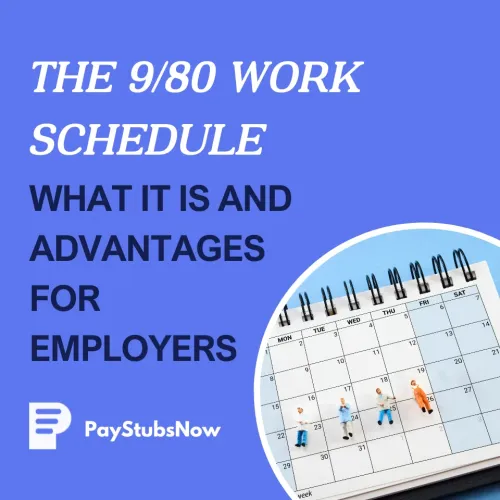


In the current talent market, organizations should be looking for innovative ways to enhance their value proposition. One increasingly popular option is the 9/80 work schedule, a work arrangement that offers a win-win scenario for both employers and employees.
This arrangement is a game-changer for employers as it helps them attract and hire top talent, increase productivity, and keep staff happy and satisfied.
In this blog post, we explain the 9/80 work schedule in detail, its advantages for employers, and how to implement it. We also discuss how employers can simplify payroll management with a powerful platform like Paystubsnow.

A 9/80 work schedule is a compacted schedule that allows employees to complete their hours over nine days within a two-week period, rather than the conventional ten-day schedule. This alternative schedule results in an extra day off every other week, creating a three-day weekend for employees.
Under this compressed work schedule, employees work eight nine-hour days and one eight-hour day. The total work hours remain 80 over the two weeks, fulfilling the standard full-time requirement by employers while granting employees every other Friday off. This alternative schedule offers a blend of extended workdays and an extra day off, appealing to both employees and employers who value flexibility and enhanced work-life balance .

While some employers may initially believe the switch to a 9/80 schedule can disrupt workflows, the following benefits justify its adoption by forward-thinking businesses:
The extended weekend break offered by the 9/80 schedule allows employees to recharge and return to work feeling refreshed and motivated. This can lead to increased focus and an overall boost in productivity during workdays.
The extra day off promotes a positive work-life balance, demonstrating an employer's commitment to employee well-being. This improved balance translates to higher morale, reducing stress and burnout among employees.
The 9/80 schedule presents a compelling perk for prospects seeking a flexible work arrangement. This makes both your company and its policies stand out from competitors in the job market and contributes to employee retention by reducing turnover.
With a healthy work-life balance, it’s less likely that employees will call in sick or use personal time off. The 9/80 schedule provides employees with time for appointments, errands, and other personal obligations, potentially resulting in fewer unplanned absences.
The 9/80 schedule isn't a rigid model. Some variations involve working longer days for four days, followed by a day off, resulting in a four-day workweek. This flexibility allows employers to explore variations that suit their specific needs and employee preferences.
With the entire team present for nine consecutive days, the flow of communication and collaboration is optimized. This uninterrupted work period can potentially streamline projects and workflows, leading to increased operational efficiency.

Although it is promising, there are certain inherent challenges to consider when deciding if the 9/80 work schedule is right for your company. Some of these challenges include:
Implementing a 9/80 schedule often involves staggering employee start and end times to ensure adequate staffing throughout the day. This can lead to scheduling conflicts, especially for teams that require consistent collaboration or rely on specific team members during particular hours.
Individual employee preferences and availability can also create scheduling challenges. Ensuring that everyone's needs are considered while maintaining optimal team coverage can be complex.
The 9/80 schedule involves varying work hours each week, which can complicate payroll calculations. Accurately tracking overtime, breaks, and other pay-related factors requires careful attention and potentially specialized payroll software.
Depending on your location, local labor laws may have specific regulations regarding overtime pay and work-hour limits. Employers must ensure compliance with these laws to avoid legal issues. Some jurisdictions have specific requirements for breaks during extended workdays. Adhering to these regulations is crucial to maintaining a safe and compliant workplace environment.
The 9/80 schedule may not be suitable for all teams or departments in an organization. Teams that require constant face-to-face interaction or rely heavily on specific individuals during particular hours may find it challenging to adapt to this schedule.
This change can also impact a business that provides services directly to consumers. If that business needs to be open during specific hours, it might have to adjust its operating hours or the number of staff it has to adapt to a new 9/80 schedule.

Successfully implementing a 9/80 work schedule requires careful planning and consideration. Here are the key steps employers should follow:
This crucial initial step helps determine if the 9/80 schedule is a viable option for your organization and its unique needs. It prevents unnecessary disruption and ensures that the implementation aligns with business goals . Here are some tips to carry out a careful evaluation:
Pro Tip: Research how other companies in your industry have implemented compressed workweeks and learn from their experiences.
Employee buy-in is crucial for the successful implementation of any new work schedule. Consulting employees encourages open communication, builds trust, and ensures that their concerns and preferences are acknowledged. Start by collecting feedback via:
Be transparent about the potential benefits and challenges of the 9/80 schedule. Actively listen to employee concerns and address them openly and honestly. Be willing to adjust the proposed schedule based on employee feedback and suggestions.
Adhering to labor laws is crucial to avoid legal issues, maintain a positive and ethical work environment, and protect your company's reputation. Non-compliance can result in fines, lawsuits, and damage to employee morale. Here's what you can do to ensure compliance:
Review Relevant Laws: Thoroughly review all applicable federal, state, and local labor laws related to:
Overtime Pay: Understand overtime regulations for compressed workweeks. Determine the overtime threshold and ensure accurate overtime calculations. The Fair Labor Standards Act establishes regulations regarding overtime compensation for non-exempt employees who exceed 40 hours of work in a week, typically at a rate of one and a half times their regular pay.
Meal and Rest Breaks: Ensure compliance with regulations regarding meal and rest breaks, especially during extended workdays.
Minimum Wage: Confirm that the 9/80 schedule does not result in employees falling below the minimum wage.
Other Relevant Laws: Consider any other relevant laws, such as those related to employee privacy, data security, and workplace safety.
Consult Legal Counsel: Seek guidance from legal counsel specializing in employment law to ensure full compliance with all relevant regulations.
Develop Clear Policies: Create clear company policies that outline the 9/80 work schedule, including eligibility criteria, overtime rules, break schedules, and any other relevant guidelines. These policies should be easily accessible to all employees.
Accurately tracking and calculating employee pay is essential for maintaining accurate payroll records. This proactive approach can help ensure employee satisfaction and prevent costly errors. Here's how you can optimize your payroll system:
The 9/80 work schedule benefits greatly from continuous monitoring and optimization. To ensure the long-term success of this work schedule, improvements should be made based on employee feedback and data from their performance. Here's what you should be tracking daily:
Conducting regular check-ins with employees to gather feedback on their experiences with the 9/80 schedule is a great way to keep your finger on your staff's pulse. Periodically hold focus groups to discuss any challenges or concerns and brainstorm potential solutions.
If you're interested in the 9/80 work schedule concept and wondering what it looks like, here's a sample two-week work calendar illustrating this work schedule:
First week:
Second week:
Please Note:
This sample schedule illustrates a typical 9/80 workweek with nine-hour days for eight days, followed by a shorter workday or a full day off.
Managing payroll for a traditional work schedule can be challenging enough, but implementing a 9/80 schedule adds another layer of complexity. Thankfully, solutions exist to simplify payroll processing for businesses with alternative work schedules.
At Paystubsnow , we offer a user-friendly online payroll platform that empowers employers to streamline payroll documentation generation tasks with:
With Paystubsnow, businesses can manage complex payroll tasks for a 9/80 schedule with greater efficiency and accuracy.